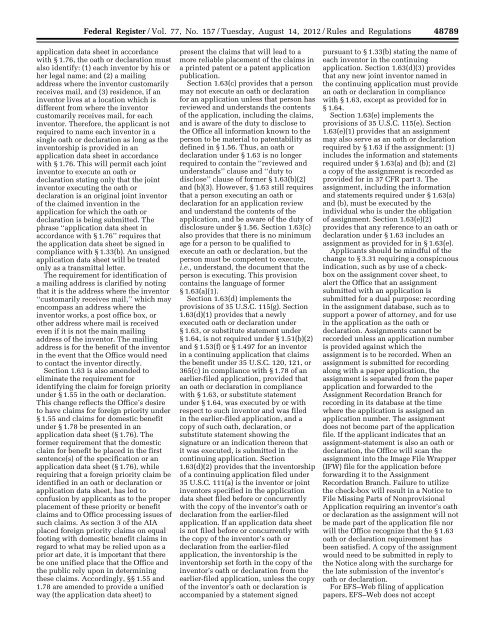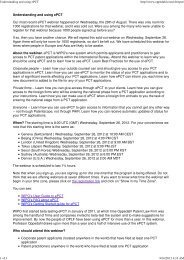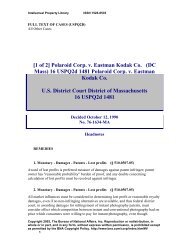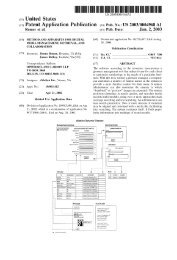sro<strong>be</strong>rts on DSK5SPTVN1PROD with RULES48788 Federal Register / Vol. 77, No. 157 / Tuesday, August 14, 2012 / Rules and Regulationswith § 1.64, executed by or with respectto each actual inventor.Section 1.53(f)(4) contains theprovisions of former § 1.53(f)(3).Section 1.53(f)(5) contains theprovisions of former § 1.53(f)(4).Section 1.53(f)(6) contains theprovisions of former § 1.53(f)(5).Section 1.53(h) is amended to providean exception for the situation in whichthe inventor’s oath or declaration is notfiled until the application is otherwisein condition for allowance under§ 1.53(f)(3).Section 1.55: Sections 1.55(a)(1)(i),(c), and (d)(1)(ii) are amended to requirea foreign priority claim <strong>be</strong> identified inan application data sheet (§ 1.76). 35U.S.C. 119(b) does not specify theparticular location in the application forsetting forth a claim to the <strong>be</strong>nefit of aprior foreign application. Additionally,§ 1.55 formerly did not specify where inthe application a foreign priority claimmust <strong>be</strong>, but former § 1.63(c) requiredthat the foreign priority claim <strong>be</strong> in anapplication data sheet or identified inthe oath or declaration. The change to§ 1.55 in this final rule establishes asingle location for the foreign priorityclaim in the application data sheet,which would facilitate applicationprocessing by providing practitionerswith a clear location for the foreignpriority claim, and the Office with onelocation to locate the foreign priorityclaim quickly. Formerly, the Office hadto look at the specification, amendmentsto the specification, the oath ordeclaration, the application data sheet(if provided), and elsewhere todetermine the priority claim. Inaddition, when applicants providedinconsistent information relating to theclaim for foreign priority, the Office hadto then determine which priority claimgoverned.Additionally, providing thisinformation in a single location willfacilitate review of patents and patentapplication publications, <strong>be</strong>causeapplications frequently set forth a<strong>be</strong>nefit and/or foreign priority claim inthe first sentence(s) of the specification,which is superseded by an applicationdata sheet that includes a different<strong>be</strong>nefit or foreign priority claim, andthus the <strong>be</strong>nefit claim and/or foreignpriority information contained on thefront page of the patent or patentapplication publication is different fromthe <strong>be</strong>nefit claim and/or foreign priorityclaim included in the first sentence(s) ofthe specification. While the <strong>be</strong>nefit and/or foreign priority claim on the frontpage of the patent or patent applicationpublication is usually correct, anyone(including an examiner, a practitioner orthe public) reviewing the patent orpatent application publication mustreview the file history of the applicationto <strong>be</strong> certain of its correctness. Sincemost applications are filed with anapplication data sheet, requiring the<strong>be</strong>nefit and/or foreign priority claims to<strong>be</strong> included in the application datasheet will not require most practitionersto change their practice.35 U.S.C. 119(b) provides that theforeign application is identified byspecifying the application num<strong>be</strong>r,country or intellectual propertyauthority, and filing date of each foreignapplication for which priority isclaimed. Section 1.55(a)(1) and (c) thusprovide that the foreign priority claimmust identify the foreign application forwhich priority is claimed by specifyingthe application num<strong>be</strong>r, country (orintellectual property authority), day,month, and year of its filing. Inaddition, § 1.55(a)(1)(i) requiresidentification of any foreign applicationhaving a filing date <strong>be</strong>fore that of theapplication for which priority isclaimed by specifying the applicationnum<strong>be</strong>r, country (or intellectualproperty authority), day, month, andyear of its filing. Providing thisinformation in the application datasheet constitutes the claim for foreignpriority as required by 35 U.S.C. 119(b)and § 1.55(a).Section 1.56: Section 1.56(c)(3) isamended to indicate that its provisionsalso apply to every other person who issubstantively involved in thepreparation or prosecution of theapplication and who is associated withthe inventor, the applicant, an assignee,or anyone to whom there is anobligation to assign the application.This change is for consistency with thechange in practice concerning who isthe applicant for patent in § 1.42.Section 1.59: Section 1.59(a)(2) isamended to refer to any preliminaryamendment present on the filing date ofthe application in the parenthetical forconsistency with § 1.115(a)(1).Section 1.63: Section 1.63(a) providesthat the inventor, or each individualwho is a joint inventor of a claimedinvention, in an application for patentmust execute an oath or declarationdirected to the application, except asprovided for in § 1.64. See 35 U.S.C.115(a). Section 1.63(a) further providesthat an oath or declaration must: (1)Identify the inventor or joint inventorexeuting the oath or declaration by hisor her legal name; (2) identify theapplication to which it is directed; (3)include a statement that the personexecuting the oath or declaration<strong>be</strong>lieves the named inventor or jointinventor to <strong>be</strong> the original inventor oran original joint inventor of a claimedVerDate Mar2010 17:28 Aug 13, 2012 Jkt 226001 PO 00000 Frm 00014 Fmt 4701 Sfmt 4700 E:\FR\FM\14AUR6.SGM 14AUR6invention in the application for whichthe oath or declaration is <strong>be</strong>ingsubmitted; and (4) state that theapplication was made or was authorizedto <strong>be</strong> made by the person executing theoath or declaration. The requirementsthat an oath or declaration include astatement that the person executing theoath or declaration <strong>be</strong>lieves the namedinventor or joint inventor to <strong>be</strong> theoriginal inventor or an original jointinventor of a claimed invention in theapplication for which the oath ordeclaration is <strong>be</strong>ing submitted, and statethat the application was made or wasauthorized to <strong>be</strong> made by the personexecuting the oath or declaration arerequirements of 35 U.S.C. 115(a) and (b).The requirements that an oath ordeclaration must identify the inventoror joint inventor executing the oath ordeclaration by his or her legal name andidentify the application to which it isdirected are necessary for the Office toensure that there is compliance with therequirement of 35 U.S.C. 115(a) thateach individual who is the inventor ora joint inventor of a claimed inventionin an application for patent hasexecuted an oath or declaration inconnection with the application (exceptas provided in 35 U.S.C. 115).Section 1.63(a)(1) simplifies therequirement for the inventor’s name to<strong>be</strong> his or her legal name withoutreference to a family or given name. Therequirement for the inventor’s legalname is sufficient, given thatindividuals do not always have both afamily name and a given name, or havevarying understandings of what a‘‘given’’ name requires.Section 1.63(a)(2) contains thelanguage of former § 1.63(b)(1)(requiring identification of theapplication to which the oath ordeclaration is directed).Section 1.63(a)(3) no longer includesa requirement for identifying thecountry of citizenship for each inventor,as this information is no longer requiredby 35 U.S.C. 115.Section 1.63(a)(4) no longer includesthe requirement that the personexecuting the oath or declaration statethat he or she is <strong>be</strong>lieved to <strong>be</strong> the‘‘first’’ inventor, as this statement is nolonger provided for by 35 U.S.C115(b)(2) and would not <strong>be</strong> consistentwith a first inventor to file system.Section 1.63(a)(4) does include arequirement from 35 U.S.C. 115(b)(1),not present in former 35 U.S.C. 115 or§ 1.63, that the oath or declaration statethat the application was made or wasauthorized to <strong>be</strong> made by the personexecuting the oath or declaration.Section 1.63(b) provides that unlesssuch information is supplied in an
Federal Register / Vol. 77, No. 157 / Tuesday, August 14, 2012 / Rules and Regulations48789sro<strong>be</strong>rts on DSK5SPTVN1PROD with RULESapplication data sheet in accordancewith § 1.76, the oath or declaration mustalso identify: (1) each inventor by his orher legal name; and (2) a mailingaddress where the inventor customarilyreceives mail, and (3) residence, if aninventor lives at a location which isdifferent from where the inventorcustomarily receives mail, for eachinventor. Therefore, the applicant is notrequired to name each inventor in asingle oath or declaration as long as theinventorship is provided in anapplication data sheet in accordancewith § 1.76. This will permit each jointinventor to execute an oath ordeclaration stating only that the jointinventor executing the oath ordeclaration is an original joint inventorof the claimed invention in theapplication for which the oath ordeclaration is <strong>be</strong>ing submitted. Thephrase ‘‘application data sheet inaccordance with § 1.76’’ requires thatthe application data sheet <strong>be</strong> signed incompliance with § 1.33(b). An unsignedapplication data sheet will <strong>be</strong> treatedonly as a transmittal letter.The requirement for identification ofa mailing address is clarified by notingthat it is the address where the inventor‘‘customarily receives mail,’’ which mayencompass an address where theinventor works, a post office box, orother address where mail is receivedeven if it is not the main mailingaddress of the inventor. The mailingaddress is for the <strong>be</strong>nefit of the inventorin the event that the Office would needto contact the inventor directly.Section 1.63 is also amended toeliminate the requirement foridentifying the claim for foreign priorityunder § 1.55 in the oath or declaration.This change reflects the Office’s desireto have claims for foreign priority under§ 1.55 and claims for domestic <strong>be</strong>nefitunder § 1.78 <strong>be</strong> presented in anapplication data sheet (§ 1.76). Theformer requirement that the domesticclaim for <strong>be</strong>nefit <strong>be</strong> placed in the firstsentence(s) of the specification or anapplication data sheet (§ 1.76), whilerequiring that a foreign priority claim <strong>be</strong>identified in an oath or declaration orapplication data sheet, has led toconfusion by applicants as to the properplacement of these priority or <strong>be</strong>nefitclaims and to Office processing issues ofsuch claims. As section 3 of the AIAplaced foreign priority claims on equalfooting with domestic <strong>be</strong>nefit claims inregard to what may <strong>be</strong> relied upon as aprior art date, it is important that there<strong>be</strong> one unified place that the Office andthe public rely upon in determiningthese claims. Accordingly, §§ 1.55 and1.78 are amended to provide a unifiedway (the application data sheet) topresent the claims that will lead to amore reliable placement of the claims ina printed patent or a patent applicationpublication.Section 1.63(c) provides that a personmay not execute an oath or declarationfor an application unless that person hasreviewed and understands the contentsof the application, including the claims,and is aware of the duty to disclose tothe Office all information known to theperson to <strong>be</strong> material to patentability asdefined in § 1.56. Thus, an oath ordeclaration under § 1.63 is no longerrequired to contain the ‘‘reviewed andunderstands’’ clause and ‘‘duty todisclose’’ clause of former § 1.63(b)(2)and (b)(3). However, § 1.63 still requiresthat a person executing an oath ordeclaration for an application reviewand understand the contents of theapplication, and <strong>be</strong> aware of the duty ofdisclosure under § 1.56. Section 1.63(c)also provides that there is no minimumage for a person to <strong>be</strong> qualified toexecute an oath or declaration, but theperson must <strong>be</strong> competent to execute,i.e., understand, the document that theperson is executing. This provisioncontains the language of former§ 1.63(a)(1).Section 1.63(d) implements theprovisions of 35 U.S.C. 115(g). Section1.63(d)(1) provides that a newlyexecuted oath or declaration under§ 1.63, or substitute statement under§ 1.64, is not required under § 1.51(b)(2)and § 1.53(f) or § 1.497 for an inventorin a continuing application that claimsthe <strong>be</strong>nefit under 35 U.S.C. 120, 121, or365(c) in compliance with § 1.78 of anearlier-filed application, provided thatan oath or declaration in compliancewith § 1.63, or substitute statementunder § 1.64, was executed by or withrespect to such inventor and was filedin the earlier-filed application, and acopy of such oath, declaration, orsubstitute statement showing thesignature or an indication thereon thatit was executed, is submitted in thecontinuing application. Section1.63(d)(2) provides that the inventorshipof a continuing application filed under35 U.S.C. 111(a) is the inventor or jointinventors specified in the applicationdata sheet filed <strong>be</strong>fore or concurrentlywith the copy of the inventor’s oath ordeclaration from the earlier-filedapplication. If an application data sheetis not filed <strong>be</strong>fore or concurrently withthe copy of the inventor’s oath ordeclaration from the earlier-filedapplication, the inventorship is theinventorship set forth in the copy of theinventor’s oath or declaration from theearlier-filed application, unless the copyof the inventor’s oath or declaration isaccompanied by a statement signedVerDate Mar2010 17:28 Aug 13, 2012 Jkt 226001 PO 00000 Frm 00015 Fmt 4701 Sfmt 4700 E:\FR\FM\14AUR6.SGM 14AUR6pursuant to § 1.33(b) stating the name ofeach inventor in the continuingapplication. Section 1.63(d)(3) providesthat any new joint inventor named inthe continuing application must providean oath or declaration in compliancewith § 1.63, except as provided for in§ 1.64.Section 1.63(e) implements theprovisions of 35 U.S.C. 115(e). Section1.63(e)(1) provides that an assignmentmay also serve as an oath or declarationrequired by § 1.63 if the assignment: (1)includes the information and statementsrequired under § 1.63(a) and (b); and (2)a copy of the assignment is recorded asprovided for in 37 CFR part 3. Theassignment, including the informationand statements required under § 1.63(a)and (b), must <strong>be</strong> executed by theindividual who is under the obligationof assignment. Section 1.63(e)(2)provides that any reference to an oath ordeclaration under § 1.63 includes anassignment as provided for in § 1.63(e).Applicants should <strong>be</strong> mindful of thechange to § 3.31 requiring a conspicuousindication, such as by use of a checkboxon the assignment cover sheet, toalert the Office that an assignmentsubmitted with an application issubmitted for a dual purpose: recordingin the assignment database, such as tosupport a power of attorney, and for usein the application as the oath ordeclaration. Assignments cannot <strong>be</strong>recorded unless an application num<strong>be</strong>ris provided against which theassignment is to <strong>be</strong> recorded. When anassignment is submitted for recordingalong with a paper application, theassignment is separated from the paperapplication and forwarded to theAssignment Recordation Branch forrecording in its database at the timewhere the application is assigned anapplication num<strong>be</strong>r. The assignmentdoes not <strong>be</strong>come part of the applicationfile. If the applicant indicates that anassignment-statement is also an oath ordeclaration, the Office will scan theassignment into the Image File Wrapper(IFW) file for the application <strong>be</strong>foreforwarding it to the AssignmentRecordation Branch. Failure to utilizethe check-box will result in a Notice toFile Missing Parts of NonprovisionalApplication requiring an inventor’s oathor declaration as the assignment will not<strong>be</strong> made part of the application file norwill the Office recognize that the § 1.63oath or declaration requirement has<strong>be</strong>en satisfied. A copy of the assignmentwould need to <strong>be</strong> submitted in reply tothe Notice along with the surcharge forthe late submission of the inventor’soath or declaration.For EFS–Web filing of applicationpapers, EFS–Web does not accept
- Page 1:
UNIFORM CERTIFICATE OF ATTENDANCE F
- Page 4 and 5:
SPTO explains the America Invents A
- Page 6 and 7:
PTO/SB/01A (01-09)Approved for use
- Page 8 and 9:
PTO/SB/ (06-12)Approved for use thr
- Page 10 and 11:
PTO/ (06-12)Approved for use throug
- Page 12 and 13:
PTO/(06-1Approved for use through 0
- Page 14 and 15: What will change about the oath ord
- Page 16 and 17: Action item●●●If you have not
- Page 18 and 19: But 37 CFR § 1.63 says:A person ma
- Page 20 and 21: ●●●Combined assignment anddec
- Page 22 and 23: ●●●●●●Consequences of i
- Page 24 and 25: How to file the ADSs●●If you pr
- Page 26 and 27: Supplemental ADSAny ADS filed after
- Page 28 and 29: Provisionals●●●Rules are a bi
- Page 30 and 31: Are all assignees applicants?●●
- Page 32 and 33: Substitute Statement●●●This f
- Page 34 and 35: ●●●Docket consequences of the
- Page 36 and 37: New Rule-46 practice67●●●Rule
- Page 38 and 39: Consequences of AIA for PCT filers
- Page 40 and 41: If you are entrusted the US nationa
- Page 42 and 43: ●●●Choosing between a “bypa
- Page 44 and 45: ●●●Getting your name and addr
- Page 46 and 47: Exercises relating to September 16,
- Page 48 and 49: Important AIA webinar September 6
- Page 50 and 51: Exercises relating to September 16,
- Page 52 and 53: 48776 Federal Register / Vol. 77, N
- Page 54 and 55: sroberts on DSK5SPTVN1PROD with RUL
- Page 56 and 57: sroberts on DSK5SPTVN1PROD with RUL
- Page 58 and 59: sroberts on DSK5SPTVN1PROD with RUL
- Page 60 and 61: sroberts on DSK5SPTVN1PROD with RUL
- Page 62 and 63: sroberts on DSK5SPTVN1PROD with RUL
- Page 66 and 67: sroberts on DSK5SPTVN1PROD with RUL
- Page 68 and 69: sroberts on DSK5SPTVN1PROD with RUL
- Page 70 and 71: sroberts on DSK5SPTVN1PROD with RUL
- Page 72 and 73: sroberts on DSK5SPTVN1PROD with RUL
- Page 74 and 75: 48798 Federal Register / Vol. 77, N
- Page 76 and 77: 48800 Federal Register / Vol. 77, N
- Page 78 and 79: 48802 Federal Register / Vol. 77, N
- Page 80 and 81: 48804 Federal Register / Vol. 77, N
- Page 82 and 83: 48806 Federal Register / Vol. 77, N
- Page 84 and 85: 48808 Federal Register / Vol. 77, N
- Page 86 and 87: 48810 Federal Register / Vol. 77, N
- Page 88 and 89: 48812 Federal Register / Vol. 77, N
- Page 90 and 91: 48814 Federal Register / Vol. 77, N
- Page 92 and 93: 48816 Federal Register / Vol. 77, N
- Page 94 and 95: sroberts on DSK5SPTVN1PROD with RUL
- Page 96 and 97: sroberts on DSK5SPTVN1PROD with RUL
- Page 98 and 99: 48822 Federal Register / Vol. 77, N
- Page 100 and 101: sroberts on DSK5SPTVN1PROD with RUL
- Page 102: 48826 Federal Register / Vol. 77, N





